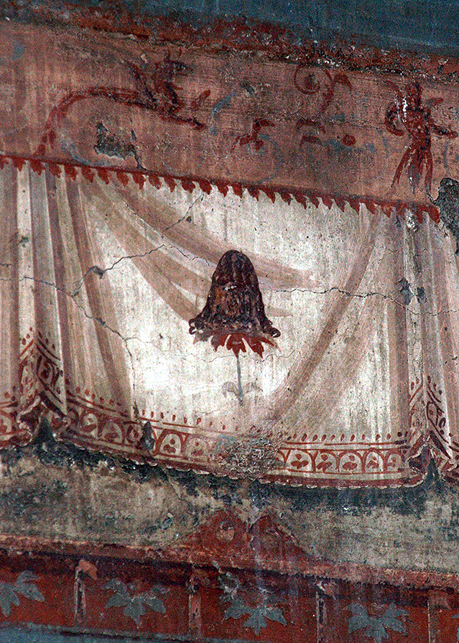
The psychology of expectations
Like Parrhasius, Roman artists created a similar deceit based upon the psychology of expectations. Instead of curtains they depicted walls perpendicular to the real wall, thus the physical wall was psychologically buried beneath its simulacra. In so doing the pictorial wall created the possibility of further vistas beyond both itself and the no longer present physical wall.
This occurred in a way in which easel painting cannot operate, because it is intentionally separated from the physical world via a frame. Wall-paintings, on the other hand, have the potential to deny the physical ground that supports them and at the same time their own presence, because they can seamlessly merge with the physical environment that houses them. They are perfect examples of what happens when the art of concealment and the concealment of art combine together (fig.1). The dynamics of which both the early first-century Roman rhetorician Quintilian and the seventeenth- century German philologist Franciscus Junius understood very well. “To be short; as in many other Arts the maine strength of Art doth principally consist in the warie concealement of Art; so doth the chiefest force and power of the Art of painting especially consist therein, that it may seeme no Art. “But we cannot endure this” sayth Quintilian, “and we thinke the Art lost, unless it doe appeare; whereas it doth rather cease to be an Art, when it is too apparent”.” (Junius, 1638, [290], Quintilian, IV, 2,127)
Previous studies have sought to provide solutions to the problem of Second Style signification by attempting to establish antecedents. This has led to a large amount of interesting material regarding developmental sources and possible influences such as Macedonian tomb painting and theatre scenography, but very little on the contemporary significance of these very early and very sophisticated examples of perspectival painting. Issues such as these are largely resolved by adopting an analytical approach based upon Erwin Panofsky’s concept of perspective as symbolic form, in which he argues that every society has its own form of perspective determined by the need to symbolise its cultural values. (Panofsky 1927) And, since no signifier is value free, even so called decorative or ornamental images must also play their part within the symbolic perspectival framework.
Panofsky’s theory in conjunction with the view that the aesthetic values inherent in Roman wall-painting are derived from concepts of decorum and not decoration, produced radically new theories concerning the social function of Roman wall-painting and these will be explored in the following chapters.

|